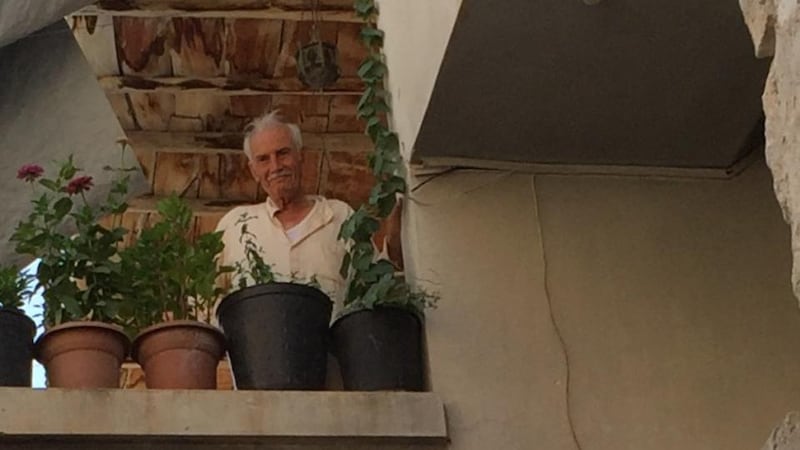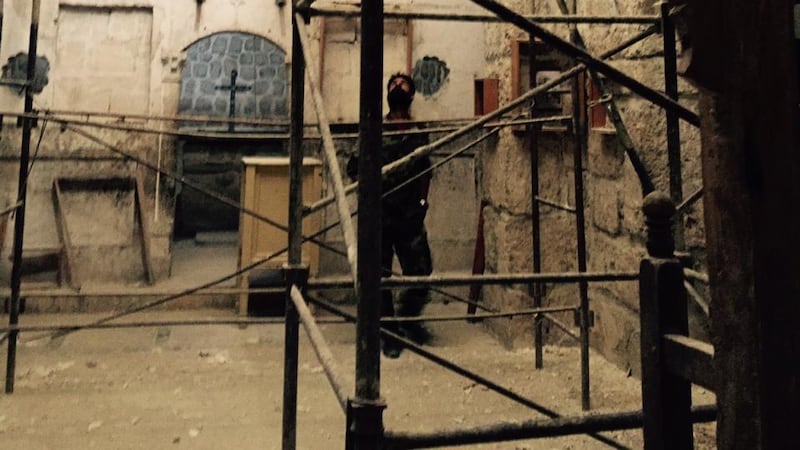The 14th-century Christian town of Maaloula is rising again from the ruins and rubble of eight months of occupation by insurgents determined to obliterate churches, convents and Aramaic, the language spoken by Jesus and his disciples.
The streets of the newer quarters and narrow alleyways of the old city are clear of debris and charred wooden beams from collapsed buildings. Street lights glow orange on lamp posts although the electricity supply is fitful and uncertain. “Just like Damascus,” says municipal councillor Joseph Saadeh.
I last visited Maaloula on April 15th, 2014, with a handful of other journalists taken by Syrian army officers to the crest of the mountain that shelters the town. Troops and Lebanese Hizbullah fighters were fighting tenacious insurgents who had taken over the town on September 4th, 2013. The rip of heavy firing and thud of explosions rose from the lower village as we crunched across broken tiles and shards of glass in the lobby of the once-fashionable Safir Hotel now, as then, blasted and burned.


The hotel's owners have not invested in a clean-up, funded in other parts of the town by the government. Money for repairing churches has come from Greek and Russian Orthodox and Catholic churches in Syria, Lebanon and further afield. The Aramaic Institute is being reconstructed with French aid.
Next to the hotel, the early fourth-century Catholic church of Mar Sarkis (St Sergius) and Bacchus, dedicated to two Roman soldiers executed for their Christian faith, has been cleaned and repaired. The stones of the vaulted roof of the church, which had collapsed on to the floor, have been replaced and heavily cemented. The courtyard has been cleared of torn books and broken religious items. But the adjacent convent’s centuries-old icons and books were stolen or destroyed.
Last year, we could not reach the Orthodox Mar Takla, half way up the town’s gorge, due to the battle. It has also now been cleared of rubble and rubbish and is being rehabilitated. Walls boast new electrical wiring and fresh paint.
The earliest sanctuary was destroyed by fire and the church of St John looted and scorched. Icons were split in half, smashed or burned. Up four flights of stairs on the platform built in a cave, the well still provides cool holy water tasting of the mountain. The tiny chapel, where Christians and Muslims both prayed, is dark and dank. Orphans who once lived here with nuns under the rule of a formidable mother superior have moved to a convent near Crac des Chevaliers, the crusader castle in the west of Syria.
Today, Maaloula has 1,000 inhabitants. Before the war, there would have been 12,000, mainly Damascenes, escaping the stifling tower blocks of the capital to savour the cool summer breezes of the Qalamoun mountains. The town normally has about 3,000 inhabitants in winter time.
Many returnees are older people who rejected exile, such as Ghattas Saadeh (82), a retired teacher who came back to his house in the old town five days after Maaloula’s “liberation”.
Leaning over his balcony, he explains, “I’ve lived in Maaloula for my whole life.”
As we stand in the narrow alley in the shade of thick, rough stone walls, Joseph, his nephew, the municipal councillor, tells us what happened in early September 2013.
“Maaloula was attacked by the Free Syrian Army backed up by [al-Qaeda-linked Jabhat] al-Nusra.” They came from the top of the mountain and quickly overpowered 50 local defenders.
“The attackers knew exactly about our weak points, who were our leaders,” states Joseph, with an edge of bitterness in his voice. “They had supporters among Muslims in the village,” who then constituted a quarter of the population.
In the 1980s, the Muslim Brotherhood began to convert some local Muslims to its ideology and Saudi Wahhabis came with their puritan teachings. Before that time, Maaloula's Muslims and Christians had lived together peacefully.
“Muslims helped us prepare for the feast of the Holy Cross on September 14th. Things began to change in 2011.”
Betrayed by co-villagers and attacked by fundamentalist fighters, the people of Maaloula fled to the neighbouring Muslim village of Ain al-Tineh, where they were welcomed. During exile, some went elsewhere. Joseph, a dentist, still lives in Ain al-Tineh.
Maaloula was once a place of pilgrimage and tourism open to all. Outsiders, including Syrians, now need army permission to visit. The townspeople and government do not want a repeat of 2013.
For Syrians, Maaloula is a symbol of Christian endurance, comfortable co-existence and a shared religious and communal history; for radical Sunnis seeking to transform Syria into a land with a single faith, Maaloula was a dangerous symbol rather than a strategic location.
Maaloula may have been wounded, but it survives in spirit and stone.












